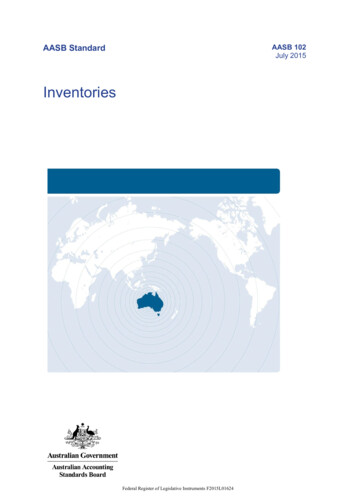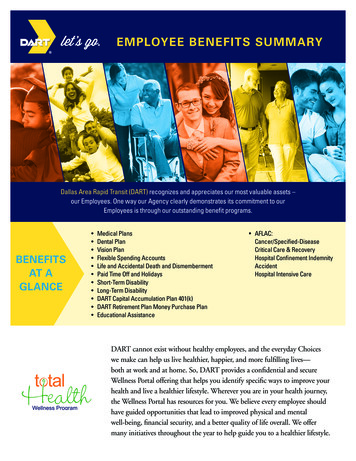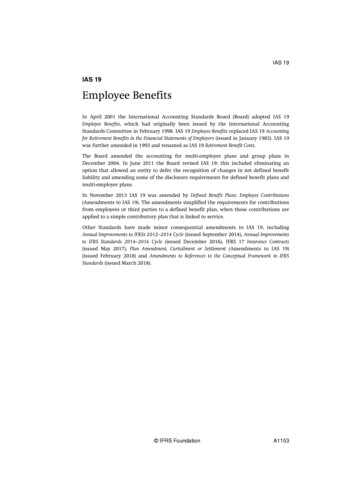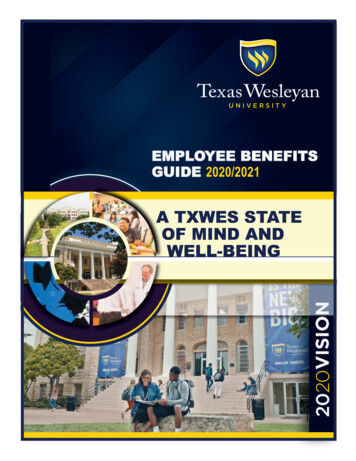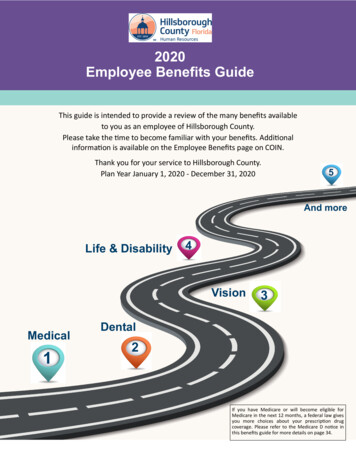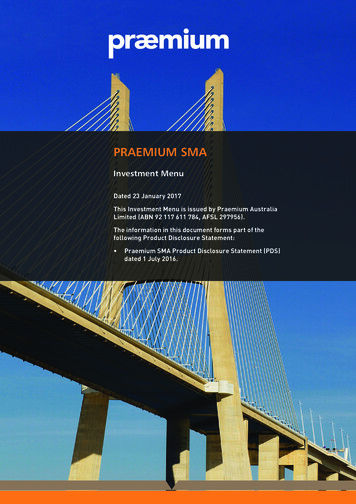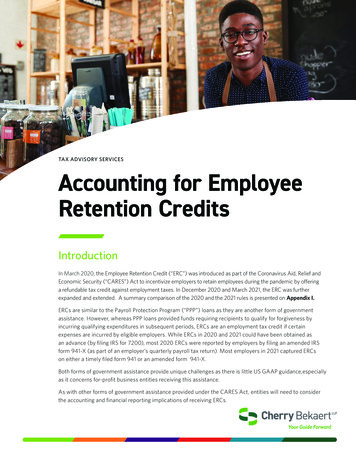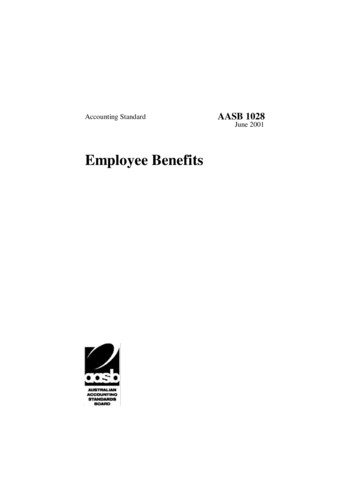
Transcription
Accounting StandardAASB 1028June 2001Employee Benefits
Obtaining a Copy of this Accounting StandardCopies of this Standard are available for purchase from the AustralianAccounting Standards Board by contacting:The Customer Service OfficerAustralian Accounting Standards BoardLevel 3530 Collins StreetMelbourne Victoria 3000AUSTRALIAPhone:Fax:E-mail:Web site:(03) 9617 7637(03) 9617 7687publications@aasb.com.auwww.aasb.com.auOther enquiries:Phone:Fax:E-mail:(03) 9617 7600(03) 9617 7608standard@aasb.com.auCOPYRIGHT 2001 Australian Accounting Standards Board. The copying of thisStandard is only permitted in certain circumstances. Enquiries should bedirected to the Australian Accounting Standards Board.ISSN 1036-4803AASB 10282
CONTENTSMAIN FEATURES OF THE STANDARD page 5Section and page number1234Application 7Operative Date 8Purpose of Standard 9Recognition 9Liabilities and Expenses Arising in Respectof Employee Benefits 9Wages and Salaries, including NonMonetary Benefits 11Compensated Absences 13Annual Leave 14Sick Leave 14Long Service Leave 15Profit Sharing and Bonus Plans 16Termination Benefits 18Liabilities for Termination BenefitsRecognised as a Part of anAcquisition of an Entity orOperation 20Post-Employment Benefits 24Assets and Revenues Arising in Respect ofEmployee Benefits 24Recognition on a Net Basis 25Revenues and Expenses 25Assets and Liabilities 26Non-Recognition of Assets andLiabilities 265Measurement 27Nominal Basis of Measurement 27Present Value Basis of Measurement 28Discount Rate 28AASB 10283CONTENTS
6Disclosures 30The Nature and Terms of Employee BenefitArrangements 30Details of Amounts Recognised inthe Financial Statements 31Equity-Based Compensation Benefits 31Equity-Based Instruments at theBeginning of the ReportingPeriod 32Equity-Based InstrumentsGranted/Distributed During theReporting Period 33Share Options and other EquityBased Instruments ExercisedDuring the ReportingPeriod 35Share Options and other EquityBased Instruments Lapsed Duringthe Reporting Period 36Equity-Based Instruments at the Endof the Reporting Period 36Superannuation 4078Transitional Arrangements 41Definitions 42APPENDIX 1A Summary of Disclosure Requirements for EquityBased Compensation Benefits 50APPENDIX 2An Illustration of Disclosure Requirements for EquityBased Compensation Benefits 52CONFORMITY WITH INTERNATIONAL AND NEWZEALAND ACCOUNTING STANDARDS 56BACKGROUND TO REVISION 59Defined words appear in italics each time they appear. Thedefinitions are in Section 8. Standards are printed in bold typeand commentary in light type.AASB 10284CONTENTS
MAIN FEATURES OF THE STANDARDThe Standard:(a)prescribes general recognition criteria for employee benefits(excluding certain equity-based compensation benefits, and postemployment benefits that are superannuation or medical benefits).In addition to prescribing general recognition criteria, the Standardprescribes specific recognition criteria for wages and salaries(including non-monetary benefits), compensated absences, profitsharing and bonus plans (including certain equity-basedcompensation benefits), termination benefits and certain postemployment benefits;(b)requires liabilities that arise in respect of wages and salaries(including non-monetary benefits), annual leave, and sick leave(regardless of whether they are expected to be settled within 12months of the reporting date) and other employee benefits expectedto be settled within 12 months of the reporting date to be measuredat their nominal amounts;(c)requires employee benefit liabilities (other than wages and salaries,annual leave and sick leave) expected to be settled more than12 months after the reporting date to be measured at present value;(d)requires the market yields on national government bonds to be usedin determining the present value of employee benefit liabilities; and(e)requires disclosures to be made about:(i)liabilities and assets that are a consequence of employingemployees;(ii)defined benefit superannuation plans;(iii)equity-based compensation benefits; and(iv)the nature and terms of arrangements under whichemployees are offered an opportunity to acquire equity inthe employer and thereby derive a benefit, directly orindirectly, by virtue of the employer/employee relationship,not otherwise specifically required to be disclosed by theStandard.In relation to the disclosures required for equity-based compensationbenefits, the Standard requires disclosure of details about equityAASB 10285FEATURES
based instruments, including share options or other similar rights(such as performance rights), granted as employee compensationduring a reporting period and, as at each subsequent reporting date,details about the instruments that remain unexercised. Disclosure isrequired of the fair value of vested fully-paid shares issued by anemployer to equity-based compensation plans or to employees ordistributed by equity-based compensation plans to employees.Future ActionThe Standard does not yet require the fair value of share options orother similar rights granted to be disclosed. This will be reviewedby the Australian Accounting Standards Board in light of theoutcome of the forthcoming proposed Standard on Director andExecutive Disclosures, which will address the disclosure of the fairvalue of such instruments. This will include consideration of thedate (or dates) at which fair value should be determined (forexample grant date and/or vesting date) and disclosed. It is likelythat amendments will be made to the Standard arising from theforthcoming Director and Executive Disclosures Standard.AASB 10286FEATURES
ACCOUNTING STANDARD AASB 1028The Australian Accounting Standards Board makes Accounting StandardAASB 1028 “Employee Benefits” under section 334 of the CorporationsLaw.F.K. AlfredsonChair – AASBDated 28 June 2001ACCOUNTING STANDARDAASB 1028 “EMPLOYEE BENEFITS”1Application1.1This Standard applies to:(a)each entity that is required to prepare financial reportsin accordance with Part 2M.3 of the Corporations Lawand that is a reporting entity;(b)general purpose financial reports of each other reportingentity; and(c)financial reports that are, or are held out to be, generalpurpose financial reports.1.1.1The standards specified in this Standard apply to the financial reportwhere information resulting from their application is material inaccordance with Accounting Standard AASB 1031 and AustralianAccounting Standard AAS 5 “Materiality”.1.2This Standard prescribes recognition requirements for allemployee benefits other than:(a)equity-based compensation benefits that will be settledwith equity instruments of the employer;(b)equity-based compensation benefits that may, as opposedto will, be settled with equity instruments of theemployer, but only until a decision is made thatemployees will not receive equity instruments of theemployer; andAASB 10287
(c)post-employment benefits that are superannuation ormedical benefits.1.2.1The definition of equity-based compensation benefits inparagraph 8.1 includes employee benefits where the amount of thebenefits depends on the future value of equity instruments of theemployer, even if equity instruments will not be issued to employees(for example, whether due to the nature of the entity or there is noprovision in the arrangement with the employee for equityinstruments to be issued). This Standard treats equity-basedcompensation benefits where equity instruments of the employer willnot be issued as profit sharing or bonus plans. This Standardprescribes recognition requirements for such benefits (seeparagraphs 4.5 to 4.6.5). In circumstances where equity-basedcompensation benefits may be settled with either equity instrumentsof the employer or other compensation in lieu, this Standard doesnot prescribe recognition requirements. However, when it is knownthat such benefits are not to be settled with equity instruments of theemployer, they are treated in the same manner as profit sharing orbonus plans. The disclosure requirements in paragraphs 6.3 to 6.9of this Standard apply to all types of equity-based compensationbenefits, including where they are treated as profit sharing or bonusplans.2Operative Date2.1This Standard applies to annual reporting periods beginning onor after 1 July 2002.2.2This Standard may be applied to annual reporting periodsbeginning before 1 July 2002. An entity that is required toprepare financial reports in accordance with Part 2M.3 of theCorporations Law may apply this Standard to annual reportingperiods beginning before 1 July 2002, where an election has beenmade in accordance with subsection 334(5) of the CorporationsLaw.2.3When applied or operative, this Standard supersedes:(a)AASB 1028Accounting Standard AASB 1028 “Accounting forEmployee Entitlements” as approved by noticepublished in Commonwealth of Australia GazetteNo. S 106 on 29 March 1994; and8
(b)Australian Accounting Standard AAS 30 “Accountingfor Employee Entitlements” as issued in March 1994.2.3.1Notice of this Standard was published in the Commonwealth ofAustralia Gazette on 29 June 2001.3Purpose of Standard3.1The purpose of this Standard is to:4(a)prescribe recognition and measurement requirementsfor employee benefits, other than certain equity-basedcompensation benefits, and post-employment benefitsthat are superannuation or medical benefits; and(b)require specific disclosures to be made in relation toemployee benefits, including equity-based compensationbenefits, and post-employment benefits that are inrespect of defined benefit superannuation plans.RecognitionLiabilities and Expenses Arising in Respect ofEmployee Benefits4.1Subject to paragraph 4.16, liabilities and expenses arising inrespect of employee benefits must be recognised when, and onlywhen:(a)they are capable of being measured reliably; and(b)in respect of:(i)expenses, it is probable that the consumption orloss of future economic benefits has occurred;and(ii)liabilities, it is probable that settlement will berequired.Paragraphs 4.2 to 4.12 must be applied in implementing theabove recognition criteria to particular types of employeebenefits.AASB 10289
4.1.1As an employer consumes employees’services, an obligation tocompensate employees for those services arises. Consequently, anexpense of the employer arises unless the amounts qualify forrecognition as assets (see paragraphs 4.1.6 and 4.2(b)). Theseobligations will normally result in either cash outflows in the currentreporting period or, if they remain unpaid, liabilities of theemployer.4.1.2Liabilities arising in respect of employee benefits need not arisesolely from legal obligations. Liabilities arising from equitable orconstructive obligations may also qualify for recognition. Forexample, an employer’s long service leave liability usuallycomprises both legal and constructive components, as discussed inparagraphs 4.4.9 and 4.4.10.4.1.3Costs that are a consequence of employing employees, but which arenot employee benefits, such as payroll tax and other similar on-costs,are recognised as liabilities and expenses when the employeebenefits to which they relate are recognised as liabilities andexpenses. For example, where the settlement of employee benefitliabilities, such as long service leave, gives rise to the payment ofemployment on-costs, such as payroll tax and workers’compensation insurance, a liability is recognised for those on-costsas well as for the employee benefits.4.1.4Liabilities arising in respect of employee benefits are recognisedwhen it is probable that settlement will be required and when theliabilities can be measured reliably. Liabilities that involve multipleindividual employee claims with differing probabilities ofsettlement, such as long service leave, are generally considered on agroup basis, rather than on the basis of individual claims.4.1.5Clarification of the application of the general recognitionrequirements specified in paragraph 4.1 for liabilities arising inrespect of employee benefits in the form of wages and salaries(including non-monetary benefits), compensated absences, profitsharing and bonus plans (including certain equity-basedcompensation benefits), termination benefits and post-employmentbenefits is provided in paragraphs 4.2 to 4.12.4.1.6Some employee benefits that are paid or become payable during areporting period may give rise to future economic benefits and thusare recognised as assets rather than as expenses. For example,consistent with Accounting Standard AASB 1019 and AustralianAccounting Standard AAS 2 “Inventories” and AccountingStandard AASB 1015 and Australian Accounting Standard AAS 21“Acquisitions of Assets” the cost of employee benefits such asAASB 102810
wages and salaries incurred in producing inventories or other assetsis included when determining the cost of the inventories or otherassets. This is because employee costs associated with inventoriesor other assets represent part of the cost of acquiring the futureeconomic benefits embodied in those assets. The consumption ofthe future economic benefits associated with the inventories or otherassets, and therefore the expense, will not occur until the inventoriesor other assets are sold or otherwise consumed.4.1.7Where the entity has paid an amount to employees that exceeds theentitlement for services rendered to date by the employees, theexcess represents future economic benefits controlled by the entitythat is recognised as an asset (prepaid expense) in accordance withparagraph 4.13. This asset represents a prepayment that will lead toa reduction in future payments or a cash refund.Wages and Salaries, including Non-MonetaryBenefits4.2When an employee has rendered service to the entity during areporting period, the entity must recognise the amount of wagesand salaries, including non-monetary benefits, expected to besettled in exchange for that service:(a)as a liability, after deducting any amount already paid;and(b)as an expense, unless recognised as part of the carryingamount of an asset in accordance with anotherAccounting Standard or an Australian AccountingStandard.4.2.1Wages and salaries (including components of a wage or salarypackage, such as payments by the employer of an employee’spersonal costs and the related fringe benefits tax) arising from theservices rendered by employees during the reporting period wouldgenerally satisfy the recognition criteria and would be recognised asexpenses unless they satisfy the recognition criteria for assets. Thisis because they are capable of being measured reliably and becauseemployees obtain their entitlement to wages and salaries as theyprovide their services.4.2.2An employer may provide employee benefits in the form of nonmonetary benefits. Such benefits may take the form of payment ofhealth insurance premiums, housing, motor vehicles, and free orsubsidised goods or services (for example, interest free or subsidisedAASB 102811
loans, including such loans that are associated with equity-basedcompensation arrangements). In most circumstances, employees’rights to non-monetary benefits do not accrue in proportion to theirperiods of service and do not accumulate. Usually, the right toreceive those benefits in each period exists irrespective of theduration of service provided by employees. In such circumstances,an employer recognises the cost associated with providing thebenefits in the period during which the benefits are taken byemployees. The amount of cost is determined on the basis of the netmarginal cost (if any) to the employer of the benefits provided. Aliability is not recognised for any non-accumulating benefits that theemployees do not take during the period.4.2.3In other circumstances, employees’entitlements to non-monetarybenefits may accrue in proportion to periods of service and/oraccumulate over a number of reporting periods. To the extent thatemployees’entitlements to non-monetary benefits are accumulatingand have not been settled, those benefits satisfy the definition ofliabilities. In such cases, the amount recognised as liabilities isdetermined on the basis of the net marginal cost (if any) to theemployer of the benefits expected to be provided. This requiresemployers to recognise as expenses (unless recognised as part of thecarrying amount of an asset in accordance with another AccountingStandard or an Australian Accounting Standard) accumulating nonmonetary benefits in the reporting periods during which employeesaccumulate those benefits and not in the reporting periods duringwhich the benefits are taken.4.2.4Where goods or services have been purchased from other entities,the net marginal cost will be the cost of the acquired goods orservices less any amount expected to be paid or payable byemployees. For example, if a retailer (employer) has a presentobligation to provide discounted merchandise to employees as aresult of their service to date, the amount recognised as liabilities isthe expected cost of the goods to the employer less any amountexpected to be paid by employees for those goods. In respect ofbenefits such as low-interest or interest-free loans to be provided toemployees, the amount recognised as liabilities is based on theexpected marginal cost to the employer of borrowing those funds,less the expected interest charged to employees. Where goods orservices that the employer produces or manufactures (for example,motor vehicles) are to be sold to employees at a discount, theamount recognised as liabilities is based on marginal productioncosts less amounts expected to be paid or payable by employees.AASB 102812
Compensated Absences4.3A liability for employee benefits in the form of compensatedabsences must be recognised when, and only when:(a)in the case of accumulating compensated absences,employees render service that entitles them to futurecompensated absences; or(b)in the case of non-accumulating compensated absences,the absences occur.4.4The liability for accumulating compensated absences must bebased on the amount that the entity expects to pay in futurereporting periods as a result of the unused entitlement that hasaccumulated as at the reporting date.4.4.1Compensated absences may include compensation paid or payablein respect of absence for various reasons including annual leave,sickness, short-term disability, maternity or paternity, sabbatical andlong service. Entitlement to compensated absences falls into twocategories: accumulating and non-accumulating.4.4.2Accumulating compensated absences are those that are carriedforward and can be used in future periods if the current period’sentitlement is not used in full. Accumulating compensated absencesmay be either vesting (that is, employees are entitled to a cashpayment for unused entitlement on leaving the entity) or non-vesting(that is, employees are not entitled to a cash payment for unusedentitlement on leaving the entity). An obligation arises as employeesrender service that increases their entitlement to future compensatedabsences. The obligation exists, and is recognised, even if thecompensated absences are non-vesting, although the possibility thatemployees may leave before they use an accumulated non-vestingentitlement affects the measurement of that obligation.4.4.3Non-accumulating compensated absences are not carried forward.They lapse to the extent that the entitlement is not used in the periodand do not entitle employees to a cash payment for unusedentitlement on leaving the entity (that is, they are non-vesting). Thismay be the case for sick leave and maternity or paternity leave. Anentity does not recognise a liability until the time of the absence,because employee service does not increase the amount of thebenefit.AASB 102813
Annual Leave4.4.4Unpaid entitlements to annual leave (including annual leaveloading) arising from services rendered by employees during thereporting period generally satisfy the criteria for recognition asliabilities specified in paragraphs 4.1 and 4.3. This is because theyare capable of being measured reliably and because employeesobtain their entitlement to annual leave as they provide their service.Sick Leave4.4.5Sick leave entitlements can be categorised as either vesting or nonvesting. Vesting sick leave entitlements accumulate and vest(whether by agreement or custom) in a similar manner to annualleave entitlements. Unpaid vested sick leave entitlementsaccumulated by employees during the reporting period satisfy thedefinition of liabilities, since the employer will have consumedemployees’services during the reporting period and entitlementsaccumulate with the provision of those services. Thus, vesting sickleave is of the same nature as annual leave.4.4.6Non-vesting sick leave entitlements may accumulate in a mannersimilar to annual leave entitlements, but do not vest and are paidonly upon a valid claim for sick leave by an employee.4.4.7In measuring the liability to be recognised for non-vestingaccumulating sick leave, only that component of the entitlementsaccumulated as at the reporting date that is expected to result inpayments to employees is recognised as a liability. This is becausenot all accumulated non-vesting entitlements will result in paymentsbeing made by the employer.4.4.8Non-vesting accumulating sick leave entitlements are normallymeasured on a group basis, rather than on the basis of individualemployees. Where experience indicates that, on average, sick leavetaken each reporting period is less than or equal to the entitlementaccruing in that period, and this experience is expected to recur infuture reporting periods, it is improbable that existing accumulatedentitlements will be used by employees. Unused entitlements giverise to a recognised liability only when it is probable that sick leavetaken in the future will be greater than entitlements that will accruein the future.AASB 102814
Long Service Leave4.4.9Whilst differences exist between the various Acts, Awards andWorkplace Agreements specifying long service leave entitlements inAustralia, the following entitlement categories are common:(a)an unconditional legal entitlement to payment arises after aqualifying period of service (usually ten or fifteen years).Accumulation of long service leave entitlement continuesafter this point, until the leave is taken. This entitlement istermed the “unconditional” entitlement category in thisStandard;(b)in certain circumstances (for example, death, retrenchment,or early retirement under some Awards), a legal entitlementto pro rata payment in lieu of long service leave arises(sometimes only after a qualifying period of service). Thisentitlement is termed the “conditional” entitlementcategory in this Standard; and(c)no legal entitlement to any payment or leave exists beforethe accumulation of the period of service necessary toqualify for the entitlement described in (a) or (b) above.This entitlement is termed the “pre-conditional” entitlementcategory in this Standard.At any point in time, an employer could have employees in morethan one of the above categories.4.4.10To the extent that it is probable that long service leave entitlementsaccumulated by employees in the unconditional, conditional and preconditional entitlement categories during the reporting period willresult in cash outflows by an employer in future reporting periods,they satisfy the criteria for recognition of a liability. The employerhas consumed employees’services during the period and theentitlement accumulates with the provision of employees’services.4.4.11It will often be possible for employers to estimate the present valueof the future cash outflows associated with their long service leaveliabilities by using “short-hand” measurement techniques. Forexample, experience may indicate that accrual of an employer’s longservice leave liability based on remuneration rates current as at thereporting date for all employees with five or more years of serviceprovides an estimate of the long service leave liability not materiallydifferent from the estimate determined by using the present valuebasis of measurement and detailed group-based estimates.AASB 102815
4.4.12Whilst most employers provide long service leave benefits toemployees directly, some employers participate in industry-basedlong service leave schemes. Where an employer has an obligation tocontribute to any funding shortfalls of such a scheme, that obligationsatisfies the definition of liabilities. This is because the employerhas a present obligation to make future cash outflows as a result ofthe long service leave scheme arrangements. Accordingly, anemployer’s obligations to industry-based long service leave schemesare recognised as a liability of the employer.4.4.13Some industry-based long service leave schemes operate so thatemployers directly meet their long service leave obligations toemployees, and subsequently receive reimbursement from thescheme for all or part of the payments made to employees. In suchcases, consistent with the requirements of paragraphs 4.3 and 4.13,employers recognise separately as liabilities the amount of paymentsexpected to be made to employees and as assets the amountexpected to be reimbursed by the scheme (see alsoparagraph 4.15.2).Profit Sharing and Bonus Plans4.54.64.6.1A liability for employee benefits in the form of profit sharing andbonus plans must be recognised when, and only when:(a)the entity has no realistic alternative but to settle theliability; and(b)the amount of the liability is capable of being measuredreliably in accordance with paragraph 4.6.A liability for employee benefits in the form of profit sharing andbonus plans is capable of being measured reliably when, andonly when, at least one of the following conditions is met:(a)there are formal terms in the plan for determining theamount of the benefit;(b)the entity determines the amounts to be paid before thetime of completion of the financial report; or(c)past practice gives clear evidence of the amount of theentity’s obligation.Under some profit sharing plans, employees receive a share of theprofit only if they remain with the entity for a specified period ormeet other criteria during subsequent periods. Such plans create aAASB 102816
constructive obligation as employees render service that increasesthe amount to be paid if they meet those criteria. The measurementof such constructive obligations reflects the probability that someemployees may leave without receiving part or all of the profitsharing payments.4.6.2The entity may have a practice of paying bonuses, even though itmay have no legal obligation to do so. In such cases, the entity has aconstructive obligation because the practice of paying bonusescreates an expectation that bonuses will be paid in the future. Themeasurement of the constructive obligation reflects the probabilitythat some employees may leave without receiving part or all of thebonus.4.6.3An obligation under profit sharing and bonus plans results fromemployee service and not from a transaction with the entity’sowners. Therefore, the entity recognises the cost of profit sharingand bonus plans as an expense rather than as a distribution of profit.4.6.4Consistent with paragraph 1.2, profit sharing and bonuses that areequity-based compensation benefits:(a)that will be settled with equity instruments of the employer;or(b)that may, as opposed to will, be settled with equityinstruments of the employer, but only until a decision ismade that employees will not receive equity instruments ofthe employer,are not required to be recognised by this Standard. In contrast,profit sharing and bonuses that are other types of equity-basedcompensation benefits, some of which are commonly referred to asstock appreciation rights, phantom schemes or shadow schemes aresubject to paragraphs 4.5 and 4.6. Disclosures about profit sharingand bonuses that are equity-based compensation benefits are madein accordance with paragraphs 6.3 to 6.9.4.6.5Section 5 of this Standard specifies measurement requirements foremployee benefit liabilities, including liabilities arising from profitsharing and bonus plans. The measurement of equity-basedcompensation benefits that will not be settled with equityinstruments of the employer is based on expected future cashoutflows, which requires an estimate to be made of the futureincrease in the price of equity instruments of the employer. Wherereliable estimates of future increases are not available, theAASB 102817
measurement of the liability is based on the price of the equityinstrument of the employer at the end of the reporting period.Termination Benefits4.74.8A liability and an expense for termination benefits exist when,and only when, the entity is presently obliged to provide benefitsthat relate to either:(a)terminating the employment of an employee or group ofemployees before the normal retirement date; or(b)providing termination benefits in accordance with avoluntary redundancy scheme.Except for liabilities for termination benefits that arise underparagraph 4.9 and qualify for recognition under paragraphs4.10(a)(ii) and 4.10(b), an entity is presently obliged to providetermination benefits when, and only when, the entity has:(a)(b)4.8.1developed a detailed formal plan for the terminationsidentifying at least:(i)the location, function, and approximatenumber of employees who will be compensatedfor terminating their services;(ii)the termination benefits for each jobclassification or function; and(iii)when the terminations will occur; andraised a valid expectation in those employees affectedthat it will carry out the terminations.The entity may be committed, by legislation, by contractual or otheragreements with employees or their representatives or by aconstructive obligation based on business practice, custom or adesire to act equitably, to make payments (or provide other benefits)to employees if it terminates
liabilities, such as long service leave, gives rise to the payment of employment on-costs, such as payroll tax and workers' compensation insurance, a liability is recognised for those on-costs as well as for the employee benefits. 4.1.4 Liabilities arising in respect of employee benefits are recognised
